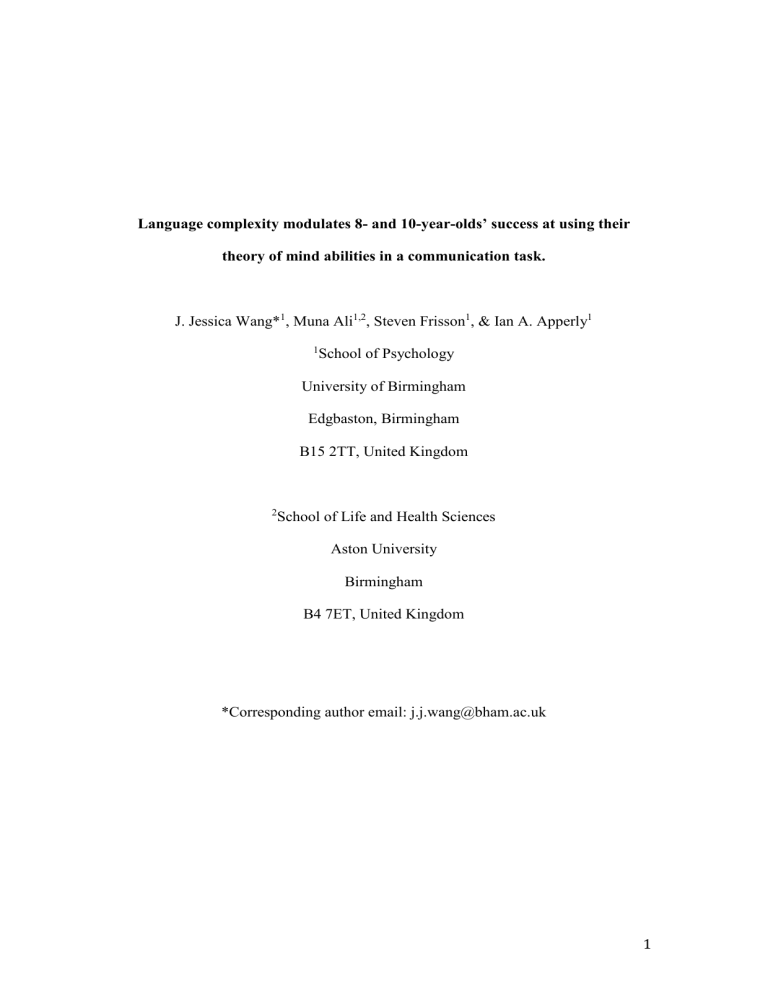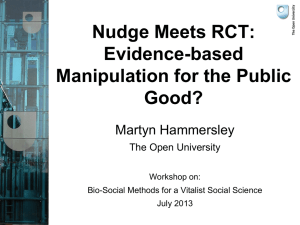Wang_et_al_JECP_final

Language complexity modulates 8- and 10-year-olds’ success at using their theory of mind abilities in a communication task.
J. Jessica Wang*
1
, Muna Ali
1,2
, Steven Frisson
1
, & Ian A. Apperly
1
1
School of Psychology
University of Birmingham
Edgbaston, Birmingham
B15 2TT, United Kingdom
2
School of Life and Health Sciences
Aston University
Birmingham
B4 7ET, United Kingdom
*Corresponding author email: j.j.wang@bham.ac.uk
1
Introduction
The ability to consider others’ perspectives is essential for human social interaction and communication. Under the banner of research on “theory of mind”, developmental psychologists have conducted hundreds of investigations of the time course, causes and consequences of children’s developing understanding of mental concepts such as belief, perception, desire, and intention from infancy into early childhood (e.g., Doherty, 2008; Gergely, Nádasdy, Csibra, Bíró, 1995; Wellman,
Cross, & Watson, 2001; Wimmer & Perner, 1983; Woodward, 1998). Recent years have also seen a burgeoning literature investigating the cognitive and neural basis of theory of mind in adult participants (e.g., Apperly, 2013, for a recent review). Among the most striking findings in this research is that healthy adults, who have a clear grasp of mental concepts, nonetheless show egocentric effects on many theory of mind tasks, observed either as a slowing of responses when judging someone whose perspective differs from their own (e.g., Samson, Apperly, Braithwaite, Andrews, &
Bodley Scott, 2010), or as a complete failure to take that perspective into account when responding (e.g., Apperly et al., 2010; Birch & Bloom, 2007; Keysar, Lin, &
Barr, 2003). These results from adults show that traditional approaches to the development of theory of mind significantly underestimate the task that they face. A full account of development must not only explain the successful acquisition of theory of mind concepts by young children. They must also account for how older children become able to use these abilities effectively in fast-moving social interactions, and ultimately explain how development arrives at the imperfect abilities observed in adults. The present research built upon one of the few studies that charted the extended development of one theory of mind ability – the use of a speaker’s visual perspective to interpret what they say. Our pilot study with healthy adults revealed a
2
clear egocentric tendency in eye movements when their communicative partner uttered complex sentences, but not when she uttered simple sentences (Wang, Cane,
Ferguson, Frisson, & Apperly, in prep). This suggests that the complexity of the speaker’s language, which has to be integrated with information about her visual perspective, affects adults’ ability to fully consider her perspective. Here we investigate how children aged 8 and 10 years are affected by the complexity of the language, and ask whether improvements in coping with such demands account for age-related reduction in egocentrism.
Before going further, a note on our terminology: the primary focus of the literature on children’s “theory of mind” has been on children’s acquisition of mental concepts. When these concepts are used to understand that another person sees or thinks something different from one’s self, the difference between self and other is a difference in “perspective” (not a difference in “theory of mind”). When this information is used to guide communication with the other person, we will describe this as “perspective-use”, which is a particular instance of “theory of mind” use.
To carry out a successful conversation, speakers and listeners must both refer to information shared between them (Clark, 1992; Clark & Marshall, 1981). For example, if a friend from school asks you to meet her at the bus stop , it is reasonable for you to assume that she is referring to the bus stop at the school gate, and not the bus stop near her house, with which you have no experience. An efficient speaker takes into account the information known and unknown to her listener. By the same token, listeners can infer which bus stop the speaker is referring to, by drawing upon their common experience of using the same bus stop at the school gate. Speakers and listeners must be able to consider each other’s perspectives and use this information online so that their conversation does not fall apart.
3
Despite the intuition that human beings are good communicators, studies suggest that even adults frequently struggle to account for their communicative partner’s perspective by fixating or selecting objects only available to themselves
(e.g., Apperly et al., 2010; Keysar et al., 2003). Clearly healthy adults do not lack the conceptual understanding that their communicative partner may hold a limited perspective. Nonetheless, the high proportion of egocentric errors – that is, incorrectly selecting the referent that best fits one’s own perspective rather than that of the speaker – observed in adults suggests that having a conceptual understanding of others’ perspective does not guarantee successful use of perspectival information in online communications (Apperly et al., 2010; Keysar et al., 2003). Moreover, there is evidence that individual differences in neurotypical adults’ rates of success at using perspective information online are related to traits associated with both autism and psychosis (Abu-Akel, Wood, Hansen, & Apperly, 2015), suggesting that these laboratory tasks may be valid tools for investigating processes that impact on realworld social abilities.
Evidence suggests that children are more egocentric than adults in both language production (Deutsch & Pechmann, 1982; Nadig & Sedivy, 2002) and language comprehension (Dumontheil, Blakemore, & Apperly, 2010; Epley,
Morewedge, & Keysar, 2004). Although sensitivity to a communicative partner’s perspective emerges as early as 3 to 5 years of age (Nadig & Sedivy, 2002; Nilsen &
Graham, 2009), there is a continuous reduction of egocentric errors on communication tasks between age 7 and 17 years (Dumontheil et al., 2010). That a continuous improvement is seen after the age at which children pass conceptual tests of visual perspective (Moll & Tomasello, 2006) and theory of mind (Wellman et al.,
2001; Wimmer & Perner, 1983) suggests that the improvement is likely driven by an
4
advancing ability to use perspectival information rather than acquiring further understanding of others’ perspectives.
Importantly, we know little about which factors make it more or less difficult for older children at any age to use perspective information successfully, and what factors account for age-related improvement. The only direct evidence on factors affecting children’s use of perspective information comes from Nilsen and Graham
(2009), who found that higher rates of egocentric errors were associated with poorer inhibitory control. Similar trends were observed for measures of working memory though these effects did not reach significance. These results converge with evidence from adults that rates of egocentric errors are higher in individuals with lower working memory scores, and can be increased under concurrent memory load (Lin,
Keysar, & Epley, 2010). However, while breaking new ground these studies leave a number of important points unclear. Firstly, while they highlight cognitive factors within the child that may contribute to performance, these studies do not identify what factors in communicative situations tax those cognitive factors. Direct manipulation of factors embedded in communication is needed to reveal the way in which inhibitory control and working memory might be key constraints. Secondly, these studies leave it unclear whether egocentric errors arise from difficulty with taking the speaker’s perspective, or from difficulty with integrating the speaker’s perspective with her speech. Barr (2008) suggests that even before a speaker refers to an object, adult listeners’ eye movements indicate that they anticipate referents to come from the common ground, not privileged ground. For adults, at least, this suggests that listeners have little difficulty calculating the speaker’s perspective, and indeed have done so prior the point at which this information can be used. In contrast, Barr (2008) suggests that integrating this perspective information with the speaker’s message in order to
5
resolve reference is relatively difficult and prone to interference from listener’s egocentric point of view (see Wu, Barr, Gann, & Keysar, 2013, for supporting evidence). It cannot be assumed that children will calculate perspectives as readily as adults, and so distinguishing between possible sources of difficulty in perspective calculation or perspective use is important for understanding when and why children might make egocentric errors in natural communication. Finally, while these studies are compatible with increasing executive capacity being responsible for age-related increases in the successful use of perspective information during communication, they provide no direct evidence on this developmental change. In the present work we sought to address the first two of these questions by varying the complexity of the language with which the speaker’s perspective must be integrated, and the final question by examining whether effects of this manipulation decrease with age.
Our approach was based on pilot work with adult participants showing egocentric tendencies in eye-movements varied according to the complexity of the speaker’s instructions (e.g., “nudge the small ball” versus “nudge the small ball one slot up”, Wang et al., in prep). In the former case, listeners could focus on reference resolution as soon as the referent-noun became available, while in the latter case this demand was combined with the requirement to continue to listen to an instruction about where to move the target item. This effect of sentence complexity illustrates one way in which executive capacity might be critical for successful performance, not for perspective-taking per se, but for enabling integration of perspective with language.
Based on these results from adults, we expected both 8- and 10-year-olds to perform more egocentrically when presented with complex sentences compared to simple sentences. Secondly, based on previous research by Dumontheil et al. (2010)
6
we expected younger children to perform more egocentrically than older children.
Finally, if the manipulation of sentence complexity also taps into a developmental factor that enables older children to be less egocentric than younger children, then we should observe an interaction between the factors of age and sentence complexity, whereby older children are less affected by sentence complexity than younger children.
Method
Participants
Thirty-nine 8-year-olds (mean age 7;9, age range 7;3 to 8;9, 16 females) and
56 10-year-olds (mean age 9;9, age range 9;2 to 10;10, 24 females) from a primary school located in a working-class region of Birmingham took part in the study.
Twenty-two 8-year-olds took part in the low sentence complexity condition, 17 took part in the high sentence complexity condition. There was no difference between the ages of the children assigned to the two conditions ( p = .656). Twenty-eight 10-yearolds took part in the low sentence complexity condition; another 28 took part in the high sentence complexity condition. There was no difference between the ages of the children assigned to the two conditions ( p = .892). An additional 11 8-year-olds and 1
10-year-old were excluded prior the analysis due to failing to pass a critical question that acted as the inclusion criterion (described in the Design and procedure section).
Design and procedure
A 2 x 2 x 2 mixed design was constructed with trial (experimental, control) as a within-participant factor, sentence complexity (low sentence complexity, high sentence complexity) and age (8 years, 10 years) as between-participant factors.
7
Children were tested individually in a quiet area outside of their classrooms. The experimenter (author M.A.) instructed children using a PowerPoint presentation on a
17” laptop. During an instruction phase, children were invited to play a game where they would have to follow a director Sally’s instruction to move objects around on a shelf. Children were first shown an example of an instruction, and a demonstration of how to select and move an object by using a computer mouse to “drag and drop” the object. The experimenter then drew children’s attention to the blocked slots, and explained that Sally cannot see the objects in the blocked slots because she is standing on the other side of the shelf. Children were then shown an image of the back of the shelf to demonstrate Sally’s limited perspective. This was followed by five check questions in which the experimenter asked children whether Sally could see certain objects. Objects from both the open and blocked slots were included in the questions to ensure that children fully understood Sally’s view of the shelf. If a child did not answer all five questions correctly, then the experimenter would repeat the aforementioned explanation about Sally’s limited perspective. No child required repeated instructions. Children were then given two example images of the shelf, which were each accompanied by an example of a critical instruction. While viewing the first shelf image, children were given an explicit example of the way in which
Sally’s perspective constrains reference. Children were told that “If Sally asks you to move the small ball , you might be tempted to move this object (experimenter pointed to the smallest ball in child’s view), but this is an object Sally cannot see, so Sally can’t be talking about this object. Instead, Sally must be talking about this object , which she can see (experimenter pointed to the small ball from Sally’s view).
Children were then asked to respond to an example of the critical instruction by using the computer mouse. Children in the low sentence complexity condition were
8
presented with audio examples of “nudge” phrases (e.g., “nudge the small ball”), whereas children in the high sentence complexity condition were presented with audio examples of “nudge-up/down/left/right” phrases (e.g., “nudge the small ball one slot up”). If children responded incorrectly, the experimenter would repeat the explanation about the way in which Sally’s view constrains reference. To help children construct a clear idea of Sally’s perspective, an image of the back of the shelf was once again shown to demonstrate Sally’s limited view of the shelf. The second example image of the shelf, which presented a different array of objects to the first example image, was designed to be an inclusion criterion, as children who understood instructions they were given up to this point should be able to respond correctly. Eleven 8-year-olds and 1 10-year-old who failed to answer this question correctly were still invited to carry on to a test phase, but their data were excluded prior the analysis.
Children were then presented with two shelf-images to practice, with each image involving 3 instructions from Sally. The practice and test trials were presented with Experiment Builder (SR Research Ltd, Mississauga, Ontario, Canada). During the test phase, a total of 32 shelf-images were presented. Each image contained a 4 x
4 shelf and the director Sally standing behind the shelf. Of the 16 slots on the shelf, 5 slots were blocked from the director’s view, with a total of 8 objects on the shelf.
When an image appeared, children had 500 ms to examine the image before hearing 2 to 3 instructions from the director, one of which was a critical instruction. A total of
80 instructions were presented, with 32 critical instructions. The critical instructions were “nudge the [scalar adjective] [noun]” in the low sentence complexity condition, and “nudge the [scalar adjective] [noun] one slot [directional word]” in the high sentence complexity condition (for a complete list of critical instructions, see
Appendix A). The remaining 48 instructions were fillers, 16 of which contained scalar
9
adjectives, 8 contained non-scalar adjectives. All sentences were spliced together from individually recorded words to eliminate the use coarticulatory information for identification of a target prior the onset of its corresponding adjective or noun.
Children were instructed to respond as quickly and accurately as possible. If children did not respond within 8500 ms, then the trial timed out, and either the next instruction was played or the next shelf-image shown.
Half of the images corresponded to the experimental trials; the other half corresponded to the control trials. On experimental trials, the object that best fit the director’s description differed between the director’s point of view and the children’s point of view. For example, when the director asked for the “small ball”, the object she referred to was X in the left panel of Figure 1 as it is the smaller of the two balls available to her (“target” hereafter). However, the object that best-fits the director’s description from the children’s point of view was Y
(“distractor” hereafter). In order to correctly select a target, it was essential that children utilized perspectival information to resolve reference. Control trials were identical to the experimental trials apart from that the distractor was replaced by an irrelevant object which did not compete with the target as a potential referent (e.g., a carton, see right panel of Figure
1). Therefore the control trials provided an appropriate baseline measure of the processing cost for the non-perspective-taking aspect of the task, which included having to comprehend the director’s instructions and use the computer mouse to identify the referent object that fitted her instructions.
Each pair of experimental and control images were presented at least 8 images apart from each other. Children were equally likely to see an experimental shelfimage before its control shelf-image as they were to see the reversed order. We presented 8 shelf-images per test block, allowing children to take breaks between the
10
blocks. Four running versions of the experiment were generated by rotating the order of the blocks and by reversing the presentation order of the shelf-images. At the end of the test phase, children were given a participation certificate and a sticker.
Y
X
Figure 1 Left: an example stimulus from an experimental trial. Right: an example stimulus from a control trial.
Results
Percentage egocentric error
Egocentric errors could occur on experimental trials, and were defined as selection of a distractor, which was an object that fits the director’s description from the children’s point of view but not the director’s point of view. Egocentric errors were not possible on control trials because an irrelevant object replaced the distractor, removing the demand to use the director’s perspective. However, since the rest of the display and the stimulus sentences were identical on the experimental and control trials, we considered the percentage of selection error to this irrelevant object as a meaningful comparison baseline. Trials containing other selection errors (8.4% in 8 year-olds; 7.2% in 10-year-olds), response timeouts (3.0% in 8 year-olds; 1.5% in 10year-olds), and technical faults (3.0% in 8 year-olds; 1.6% in 10-year-olds)
1
were
1 The experimental program was designed so that upon the detection of a mouse release, the next audio instruction was played. This means that if a child clicked more than once on the computer mouse, the
11
excluded prior to the analysis. The percentage of errors ranged from 0% to 1.1% among the control trials, in contrast with the 23% to 60% among the experimental trials. The unequal variance between the experimental and control trials and the low error rate among the control trials made it questionable to include this factor in an omnibus analysis. Therefore we only submitted the experimental trials to a 2 x 2 between-participant ANOVA, with sentence complexity (low sentence complexity, high sentence complexity) and age (8 years, 10 years) as factors 2 . There was a significant main effect of sentence complexity, F (1, 91) = 23.67, p < .0001,
ηp 2
= .206
(low sentence complexity = 28.4%, high sentence complexity = 53.0%), and a significant main effect of age, F (1, 91) = 6.10, p = .015,
ηp 2
= .063 (8 years = 46.9%,
10 years = 34.4%). The interaction between sentence complexity and age was not significant, F < 1, see Figure 2. This suggests that children of both age groups were more egocentric when presented with complex sentences compared to simple sentences. The egocentric tendency was found to decrease with age, which adds support to the findings from Dumontheil et al. (2010). However, 10-year-olds were equally affected by the complexity of the director’s utterances as their 8-year-old counterparts. instruction following the twice-clicked instruction would be played prematurely. We excluded these trials as the onset of the instructions were likely to be unexpected by the participating child.
2 The pattern observed here in the 2 x 2 ANOVA holds for analysis of overall errors when we included trial (experimental, control) as a factor in a 2 x 2 x 2 mixed ANOVA.
12
70%
60%
50%
40%
30%
20%
10%
0%
Low-sentence complexity
High-sentence complexity
Low-sentence complexity
High-sentence complexity
8 year olds 10 year olds
Figure 2 Percentage egocentric errors on experimental trials. Error bars correspond to one standard error.
Response time
The high error rates among the experimental trials meant that it was common for a child’s mean response time for a given condition to be comprised of few data points. The implication is that the response time data could not be interpreted with confidence, as the results were likely to be inflated by the variance induced by insufficient data points. For transparency, we report the descriptive statistics in
Appendix B.
General Discussion
Consistent with previous research, clear egocentric effects were observed in errors (e.g., Dumontheil et al., 2010; Keysar et al., 2003; Nilsen & Graham, 2009).
Also consistent with previous work (Dumontheil et al., 2010) the present study showed that 10-year-olds committed fewer egocentric errors than 8-year-olds. This result underscores an important point that is frequently overlooked in studies of
13
theory of mind abilities with a narrow focus on preschool children: Although the conceptual understanding of visual perspective and other aspects of theory of mind develops by 5 years of age (Moll & Tomasello, 2006; Wellman et al., 2001; Wimmer
& Perner, 1983), the ability to use information about other’s perspective has a much more protracted developmental course, with egocentric biases and errors observed even in adults (e.g., Apperly et al., 2010; Birch & Bloom, 2007; Mitchell et al., 1996;
Royzman et al., 2003).
One key objective in the present study was to examine how children are affected by the complexity of the instructions with which they must integrate the speaker’s perspective. We found that both 8- and 10-year-olds made more egocentric errors when the speaker’s utterance was more complex (e.g., “nudge the small ball one slot up”) compared with when it was simple (e.g., “nudge the small ball”). This highlights an important new performance factor that is likely to contribute to variation in the success of children’s everyday use of perspective information. It is noteworthy that in comparison with conversational discourse, neither type of instruction was particularly long or complicated, and the difference between them was relatively small. Thus, it is likely that the current results underestimate the variance in successful use of perspective that results from variation in sentence complexity in natural discourse. Finally, we note that the additional sentence complexity occurred after the critical adjectival noun phrase with which the director’s perspective must be integrated (“small ball” in the above example), at a point when participants had already had considerable time to calculate the speaker’s perspective 3 . This suggests
3 It is unlikely that participants struggled to calculate the speaker’s perspective within the time given.
Nadig and Sedivy (2002) showed that children age 5 to 6 years spontaneously distinguish what is and is not visible to a speaker before the speaker has completely delivered the noun phrase. Furthermore, if children in the current study were unable to calculate the speaker’s perspective in time to resolve reference, then performance should be at floor level, especially when the critical instruction was the
14
that the resulting increase in egocentric errors arose from increased difficulty with integrating language and perspective, rather than with calculating the director’s perspective. Altogether these results fit well with previous evidence suggesting that the rates of egocentric errors in children and adults are related to individual differences in executive function (e.g., Lin et al., 2010; Nilsen & Graham, 2009). It seems plausible that such resources are needed to meet the demands of integrating perspective with language, and that language complexity is a critical factor that determines whether an individual’s resources will be sufficient for success in a given instance.
Our second key objective was to seek evidence on what drives age-related reduction in egocentrism. Previous work has found correlations between egocentric errors on the director task and children’s inhibitory control (Nilsen & Graham 2009), and adults’ working memory spans (Lin et al., 2010), and the present work found that children made more egocentric errors when the director’s instructions were more complex. These results suggest plausible candidates for drivers of developmental improvements in egocentrism, but provide no direct evidence. One contribution of the present investigation is to operationalize a way to address this question for research on perspective-taking and theory of mind performance in children: Direct evidence would come from finding a factor that affects the rate of egocentric errors less in older children than it does in younger children. In the present study we were able to ask this question by testing for an interaction between age and the effect of language complexity on children’s egocentric errors. We found no such interaction, suggesting that the age-related reduction in egocentric errors observed was not due to an agefirst instruction of the set. Both age groups performed significantly above floor level even when the critical instruction came first, t s > 9.98, p s < .0001.
15
related improvement in children’s capacity to meet the demands of integrating information about the speaker’s message with constraints from her perspective.
The present study compared 8- and 10-year-old children, and although we observed a significant effect of both age and language complexity, it is quite possible that we would also have observed an interaction between age and a manipulation of language complexity if the comparison were made over a larger age range. However, it is informative to view the current findings in the context of other studies that have reported analogous results from other paradigms. For example, Surtees and Apperly
(2012) found no interaction between age and the relative difficulty of judging someone else’s visual perspective that was either congruent or incongruent with one’s own between 6 and 10 years of age. Similarly, Apperly et al. (2011) found no interaction between age and the relative difficulty of predicting how someone will act on the basis of a true versus a false belief between 6 and 11 years of age. Taken together these results suggest that we cannot take for granted that factors affecting children’s perspective-taking and other theory of mind abilities at a given age are the same factors responsible for age-related improvements. As suggested by Apperly
(2010), it is possible that in addition to requirements on working memory and other executive functions, a further reason for older children being less egocentric than younger children might be age-related improvements in basic speed of processing.
Even when a child has the competence in principle to take someone’s perspective, if she cannot draw upon this information sufficiently quickly then she may instead produce a response based upon her own perspective. It is easy to see how this might occur under the time pressures of a laboratory task, but importantly the same pressures are equally apparent in fast-moving communication and other social situations. In this context it is noteworthy that German and Hehman (2006) found that
16
adults’ egocentrism on a belief-desire reasoning task was predicted by a measure of their processing speed as well as inhibitory control. Thus, age-related improvements in speed of processing are a factor worth exploring as a source of age-related reduction in egocentrism.
In conclusion, the present study revealed for the first time that 8- and 10-yearolds’ ability to use information about a speaker’s perspective in communication is modulated by the complexity of the speaker’s utterances. Ten-year-olds were found to be generally less egocentric than 8-year-olds, yet both age groups were equally affected by the complexity of the speaker’s utterances. Our findings suggest that the age-related improvement in using theory of mind online is not underpinned by the ability to manage complex sentences. Nevertheless, by manipulating factors embedded within a communication task, we were able to unveil task demands that affect children’s ability to use others’ perspectives. Factors such as the complexity of a speaker’s speech clearly correspond to the demand a real communicator faces in everyday social situations. Hence the present findings suggest that children will be most successful at avoiding egocentrism in communication when the discourse is relatively simple, and in particular, if speakers avoid extending utterances beyond the critical point at which perspective information must be integrated with their message.
17
Acknowledgement
The research included in this article was funded by the Economic & Social Research
Council, reference: ES/J012238/1.
18
References
Abu-Akel, A. M., Wood, S. J., Hansen, P. C., & Apperly, I. A. (2015). Perspectivetaking abilities in the balance between autism tendencies and psychosis proneness. Proceedings of the Royal Society B , 282 : 20150563.
Apperly, I. A. (2003). Can theory of mind grow up? Mindreading in adults, and its implications for the development and neuroscience of mindreading. In Baron-
Cohen, S., Tager-Flusberg, H. & Lombardo, M. (Eds.), Understanding Other
Minds , 3rd Edition. Oxford University Press.
Apperly, I. A. (2010).
Mindreaders: The Cognitive Basis of “Theory of Mind”
.
Psychology Press.
Apperly, I. A., Carroll, D. J., Samson, D., Humphreys, G. W., Qureshi, A., & Moffitt,
G. (2010). Why are there limits on theory of mind use? Evidence from adults’ ability to follow instructions from an ignorant speaker. The Quarterly Journal of Experimental Psychology , 63 (6), 1201-1217.
Apperly, I. A., Samson, D., & Humphreys, G. W. (2009). Studies of adults can inform accounts of Theory of Mind development. Developmental Psychology , 45 (1),
190-201.
Apperly, I. A, Warren, F., Andrews, B. J., Grant, J., & Todd, S. (2011).
Developmental continuity in theory of mind: speed and accuracy of beliefdesire reasoning in children and adults. Child Development , 82 (5), 1691–1703.
Barr, D. J. (2008). Pragmatic expectations and linguistic evidence: Listeners anticipate but do not integrate common ground. Cognition , 109 (1), 18–40.
Best, J. R., & Miller, P. H. (2010). A developmental perspective on executive function. Child Development , 81 (6), 1641-1660.
19
Cane, J. E., Ferguson, H. J., Apperly, I. A. (submitted). Using perspective to resolve reference: the impact of cognitive load and motivation.
Clark, H. H. (1992). Arenas of Language Use . Chicago, IL: University of Chicago
Press. Clark,
Clark, H. H., & Marshall, C. R. (1981). Definite reference and mutual knowledge. In
A. K. Joshi, I. A. Sag, & B. L. Webber (Eds.), Elements of Discourse
Understanding . Cambridge, UK: Cambridge University Press.
Deutsch, W., & Pechmann, T. (1982). Social interaction and the development of definite descriptions. Cognition , 11 , 159–184.
Doherty, M. J. (2008).
Theory of Mind: How Children Understand Others' Thoughts and Feelings . Psychology Press.
Dumontheil, I., Apperly, I. A., & Blakemore, S.-J. (2010). Online usage of theory of mind continues to develop in late adolescence. Developmental Science , 31 (2),
331–338.
Epley, N., Morewedge, C. K., & Keysar, B. (2004). Perspective taking in children and adults: Equivalent egocentrism but differential correction. Journal of
Experimental Social Psychology , 40 , 760–768.
Gergely, G., Nádasdy, Z., Csibra, G., & Bíró, S. (1995). Taking the intentional stance at 12 months of age. Cognition, 56(2), 165-193.
German, T. P., & Hehman, J. A. (2006). Representational and executive selection resources in “theory of mind”: Evidence from compromised belief-desire reasoning in old age. Cognition , 101 , 129–152.
Keysar, B., Lin, S. & Barr, D. J. (2003). Limits on theory of mind use in adults.
Cognition, 89 , 25–41.
20
Lin, S., Keysar, B., & Epley, N. (2010). Reflexively mindblind: Using theory of mind to interpret behavior requires effortful attention. Journal of Experimental
Social Psychology , 46 (3), 551–556.
Mitchell, P., Robinson, E. J., Isaacs, J. E., & Nye, R. M. (1996). Contamination in reasoning about false belief: An instance of realist bias in adults but not children. Cognition, 59, 1-21.
Moll, H., & Tomasello, M. (2006). Level 1 perspective-taking at 24 months of age.
British Journal of Developmental Psychology , 24 (3), 603–613.
Nadig, A. S., & Sedivy, J. C. (2002). Evidence of perspective-taking constraints in children’s on-line reference resolution.
Psychological Science , 13 (4), 329–
336.
Nilsen, E. S., & Graham, S. A. (2009). The relations between children’s communicative perspective-taking and executive functioning. Cognitive
Psychology , 58 , 220–249.
Royzman, E. B., Cassidy, K. W., & Baron, J. (2003). “I know, you know:” Epistemic egocentrism in children and adults. Review of General Psychology, 7 (1), 38-
65.
Shing, Y. L., Lindenberger, U., Diamond, A., Shu-Chen, L., & Davidson, M. C.
(2010). Memory maintenance and inhibitory control differentiate from early childhood to adolescence. Developmental Neuropsychology , 35 (6), 679–697.
Sodian, B., Thoermer, C., & Metz, U. (2007). Now I see it but you don’t: 14-montholds can represent another person's visual perspective. Developmental Science ,
10 (2), 199–204.
Surtees, A. D. R., & Apperly, I. A. (2012). Egocentrism and automatic perspective taking in children and adults. Child Development , 83 (2), 452–460.
21
Wang, J. J., Cane, J. E., Ferguson, H. J., Frisson, S., & Apperly, I. A. (in prep). Why is it sometimes difficult to account for a speaker’s perspective?
Wellman, H. M., Cross, D., & Watson, J. (2001). Meta-analysis of theory-of-mind development: the truth about false belief. Child Development , 72 (3), 655–84.
Wimmer, H., & Perner, J. (1983). Beliefs about beliefs: Representation and constraining function of wrong beliefs in young children’s understanding of deception. Cognition , 13 , 103–128.
Woodward, A. L. (1998). Infants selectively encode the goal object of an actor’s reach. Cognition , 69 (1), 1-34.
Wu, S., Barr, D. J., Gann, T. M., & Keysar, B. (2013). How culture influences perspective taking: differences in correction, not integration. Frontiers in
Human Neuroscience , 7 :822.
22
Appendix A: complete list of critical instructions
High sentence complexity*
Nudge the large balloon one slot down
Nudge the large present one slot up
Low sentence complexity
Nudge the large balloon
Nudge the large present
Nudge the short plant one slot up
Nudge the narrow bottle one slot up
Nudge the narrow cup one slot up
Nudge the small ball one slot up
Nudge the short jar one slot down
Nudge the tall lamp one slot down
Nudge the tall stool one slot up
Nudge the thick cushion one slot down
Nudge the thick folder one slot down
Nudge the thin book one slot up
Nudge the thin towel one slot up
Nudge the short plant
Nudge the narrow bottle
Nudge the narrow cup
Nudge the small ball
Nudge the short jar
Nudge the tall lamp
Nudge the tall stool
Nudge the thick cushion
Nudge the thick folder
Nudge the thin book
Nudge the thin towel
Nudge the wide car one slot down
Nudge the small tin one slot down
Nudge the wide car
Nudge the small tin
Nudge the wide vase one slot down Nudge the wide vase
*The critical sentences only involved up/down directions to avoid err due to confusion over left/right. Overall there were an equal number of instructions involving each of the 4 possible directional words.
23
Appendix B: response time data
Trials containing egocentric errors (20.4% in 8 year-olds; 15.6% in 10-year-olds) and responses slower than 3.5 standard deviations from the overall mean (1.2% in 8 yearolds; 0.7% in 10-year-olds) were excluded prior to the response time analysis. Just one 8-year-old child assigned to the high sentence complexity condition was excluded from the response time analysis due to not having any data points left in the experimental trials after we applied the aforementioned exclusion criteria.
Table 1 Average response time. Numbers in brackets correspond to one standard error.
RT
(in ms)
Control
3559
(118)
Low sentence complexity
8 years
High sentence complexity
Exp
3664
(200)
Control
4295
(185)
Exp
3972
(196)
Low sentence complexity
10 years
High sentence complexity
Control
3097
(74)
Exp
3379
(99)
Control
3913
(98)
Exp
3921
(115)
24







